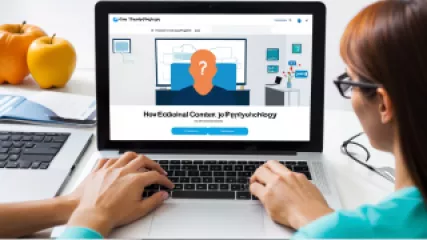How to Apply Educational Psychology Principles in Online Therapy
How to Apply Educational Psychology Principles in Online Therapy
In today's digital age, the field of educational psychology has taken on a new dimension with the rise of online therapy. As more and more individuals seek mental health support from the comfort of their own homes, the principles of educational psychology have become increasingly relevant in shaping the delivery and effectiveness of these virtual treatment modalities. In this comprehensive guide, we will explore how to apply the core tenets of educational psychology to create impactful online therapy experiences that cater to the unique needs of each client.
Understanding Educational Psychology and Its Relevance to Online Therapy
Educational psychology is a multifaceted discipline that examines the cognitive, emotional, and behavioral processes that underlie learning and development. By understanding how individuals learn, process information, and respond to different learning environments, educational psychologists have developed a wealth of strategies and techniques to optimize the educational experience.
In the context of online therapy, these same principles can be leveraged to create more engaging, personalized, and effective treatment plans. Online therapy offers a unique opportunity to tailor the therapeutic experience to the individual's learning style, cognitive abilities, and personal preferences, ultimately enhancing the likelihood of positive outcomes.
Principles of Educational Psychology in Online Therapy
As you embark on integrating educational psychology into your online therapy practice, it's essential to familiarize yourself with the key principles that can guide your approach. Let's explore some of the most impactful principles and how they can be applied in the virtual therapy setting:
1. Learner-Centered Approach
At the heart of educational psychology lies the principle of a learner-centered approach, which emphasizes the unique needs, abilities, and preferences of each individual. In the context of online therapy, this translates to a client-centered approach that tailors the therapeutic experience to the specific requirements of the individual.
This may involve:
- Conducting thorough assessments to understand the client's learning style, cognitive strengths and weaknesses, and personal goals
- Adapting the therapy format, content, and delivery to align with the client's preferences and needs
- Regularly seeking client feedback and adjusting the approach as needed to ensure optimal engagement and progress
2. Active Learning and Engagement
Educational psychology recognizes the importance of active learning, where individuals are actively engaged in the learning process rather than passively receiving information. In online therapy, this principle can be applied by:
- Incorporating interactive elements, such as multimedia, simulations, and virtual role-playing
- Encouraging regular client participation through thoughtful questioning, reflective exercises, and collaborative problem-solving
- Fostering a dynamic and engaging therapeutic environment that keeps the client invested and motivated
3. Scaffolding and Gradual Release of Responsibility
Scaffolding is a teaching strategy that involves providing support and guidance to the learner, gradually reducing that support as the individual gains competence and confidence. In online therapy, this principle can be applied by:
- Breaking down complex therapeutic concepts and skills into manageable, step-by-step progressions
- Offering structured support and guidance during the early stages of the therapeutic process
- Gradually empowering the client to take on more responsibility for their own growth and self-management as they develop the necessary skills and strategies
4. Feedback and Formative Assessment
Effective educational practices emphasize the importance of ongoing feedback and formative assessment, which help both the learner and the educator identify strengths, weaknesses, and areas for improvement. In online therapy, this can be implemented by:
- Regularly checking in with the client to assess their progress, understanding, and engagement
- Providing constructive feedback that highlights successes, acknowledges challenges, and suggests strategies for growth
- Adapting the therapeutic approach based on the client's feedback and evolving needs
5. Personalized Learning Pathways
Educational psychology recognizes that individuals learn at different paces and respond best to personalized learning experiences. In the context of online therapy, this principle can be applied by:
- Collaboratively developing individualized treatment plans that address the client's unique goals, needs, and learning preferences
- Offering flexibility in the pacing and sequencing of therapeutic activities to accommodate the client's pace of progress
- Continuously monitoring the client's response to the therapeutic interventions and making adjustments as needed
Implementing Educational Psychology in Online Therapy: Practical Strategies
Now that we've explored the key principles of educational psychology and their relevance to online therapy, let's dive into some practical strategies for implementation:
1. Comprehensive Assessment and Evaluation
Begin the therapeutic process by conducting a comprehensive assessment of the client's learning style, cognitive abilities, and mental health needs. This may involve:
- Administering standardized assessments or questionnaires to determine the client's preferred learning modalities, processing speed, and areas of strength and weakness
- Engaging the client in interactive exercises or simulations to observe their problem-solving skills, attention span, and engagement level
- Gathering detailed information about the client's personal goals, past experiences with therapy, and any specific challenges or concerns they hope to address
By gaining a deep understanding of the client's unique characteristics and needs, you can tailor the online therapy experience to optimize their learning and growth.
2. Diverse Multimedia and Interactive Elements
Leverage the capabilities of online platforms to incorporate a wide range of multimedia and interactive elements into the therapeutic experience. This may include:
- Incorporating video, audio, and visual aids to cater to different learning styles
- Designing interactive exercises, simulations, or virtual role-playing scenarios to engage the client in active learning
- Utilizing online collaboration tools, such as virtual whiteboards or shared documents, to foster interactive problem-solving and reflection
By offering a diverse array of engaging, multimedia-based interventions, you can keep the client invested and motivated throughout the therapeutic process.
3. Structured Progression and Scaffolding
Structure the online therapy sessions with a clear and logical progression, breaking down complex topics and skills into manageable steps. This scaffolding approach can involve:
- Providing explicit instructions and modeling for new therapeutic techniques or strategies
- Gradually increasing the level of difficulty or independence required as the client demonstrates mastery of the material
- Offering supportive guidance and feedback throughout the therapeutic journey to ensure the client's continued growth and confidence
By guiding the client through a well-structured, scaffolded process, you can help them develop the necessary skills and strategies to navigate their mental health challenges effectively.
4. Ongoing Feedback and Adaptation
Continuously seek feedback from the client and monitor their progress to ensure the online therapy experience remains relevant and effective. This may include:
- Regularly checking in with the client to assess their level of understanding, engagement, and satisfaction with the therapeutic interventions
- Adjusting the pace, content, or delivery of the therapy based on the client's feedback and evolving needs
- Incorporating formal and informal assessment tools to measure the client's progress and identify areas for further development
By maintaining an adaptable, client-centered approach, you can ensure that the online therapy experience continues to meet the unique needs of each individual client.
5. Fostering Self-Directed Learning and Autonomy
Ultimately, the goal of online therapy is to empower clients to become self-directed learners and active participants in their own mental health journey. To achieve this, you can:
- Encourage the client to take an active role in setting their therapeutic goals and shaping the direction of the sessions
- Provide resources, tools, and strategies that enable the client to continue their personal growth and self-management outside of the therapy sessions
- Foster a collaborative, empowering therapeutic relationship where the client feels heard, supported, and capable of achieving their desired outcomes
By cultivating the client's sense of autonomy and self-directed learning, you can help them develop the skills and confidence to manage their mental health effectively, even beyond the online therapy experience.
Conclusion: Embracing the Power of Educational Psychology in Online Therapy
As the demand for online therapy continues to grow, the principles of educational psychology offer a powerful framework for creating impactful, personalized, and engaging therapeutic experiences. By leveraging the learner-centered approach, active engagement, scaffolding, formative assessment, and personalized learning pathways, you can unlock the full potential of online therapy and empower your clients to achieve their mental health goals.
Remember, the key to success lies in your willingness to adapt, innovate, and continuously refine your approach based on the unique needs and preferences of each individual client. By embracing the principles of educational psychology, you can transform the online therapy landscape and make a lasting difference in the lives of those you serve.
In this comprehensive guide, we have explored how to apply the core tenets of educational psychology to create impactful online therapy experiences. By understanding the principles of learner-centered approaches, active learning, scaffolding, feedback, and personalized pathways, therapists can tailor the virtual treatment modality to the unique needs of each client.
Through practical strategies such as comprehensive assessment, diverse multimedia integration, structured progression, ongoing feedback, and fostering self-directed learning, therapists can leverage the power of educational psychology to enhance the effectiveness, engagement, and long-term impact of online therapy.
As the demand for virtual mental health support continues to grow, this guide serves as a valuable resource for therapists, counselors, and mental health professionals who are committed to delivering evidence-based, client-centered care in the digital age. By embracing the principles of educational psychology, they can unlock new possibilities for transformative online therapy experiences that empower clients to achieve their mental health goals.
Remember, the key to success in applying educational psychology principles to online therapy lies in your willingness to adapt, innovate, and continuously refine your approach based on the unique needs and preferences of each individual client. By embracing this client-centered mindset and leveraging the power of educational psychology, you can make a lasting difference in the lives of those you serve.
So, let's continue to explore, experiment, and evolve our online therapy practices, guided by the principles of educational psychology. Together, we can shape a future where virtual mental health support is not just accessible, but truly transformative.






